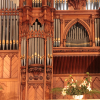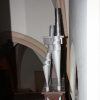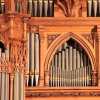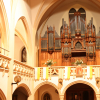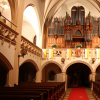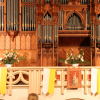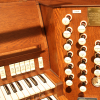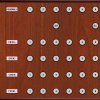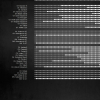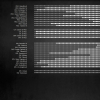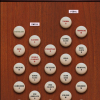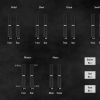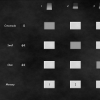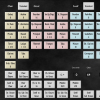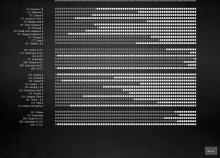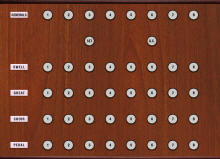William Hill English Organ Model
Hill Organ, Burton (England) - Berlin (Deutschland), ca. 1860-1870
 The organ was built in 1860s by William Hill, originally for St. Paul's Church in Burton, before being transferred and installed in the Trinity Methodist and United Reformed Church in Burton-upon-Trent in 1896. This pipe organ has wowed worshipers and music lovers there for 150 years. Rev. Julia Pellett, superintendent minister of the Burton Methodist circuit, said: "It was one of the best organs around, and people who had never heard it before were completely taken aback by the sound of it, which was just brilliant." Due to dwindling attendances the church was closed recently, and the organ found its new home in the German capital, Berlin. It was installed in St. Afra church in Gesundbrunnen in 2015.
The organ was built in 1860s by William Hill, originally for St. Paul's Church in Burton, before being transferred and installed in the Trinity Methodist and United Reformed Church in Burton-upon-Trent in 1896. This pipe organ has wowed worshipers and music lovers there for 150 years. Rev. Julia Pellett, superintendent minister of the Burton Methodist circuit, said: "It was one of the best organs around, and people who had never heard it before were completely taken aback by the sound of it, which was just brilliant." Due to dwindling attendances the church was closed recently, and the organ found its new home in the German capital, Berlin. It was installed in St. Afra church in Gesundbrunnen in 2015.
The builder of the organ was William Hill (1789-1871), an apprentice of Thomas Elliot. His career is remarkable within English organbuilding. In 1925, he became a co-owner of the company Elliot & Hill, later renamed to Hill & Son. The company soon earned an excellent reputation. Hill was an innovative figure, experimenting with large compasses (keyboards extended to low CC), large scales, new stop types, and high wind pressures. In 1840, his Birmingham Town Hall instrument was the first organ in the world to have a high pressure reed stop, a feature which later became the landmark of the English organ, named usually the Grand Ophicleide or Tuba Mirabilis. By the middle of the 19th century, he developed an organ style that represented a radical departure from the older English style. It was called the "German system". All manual divisions commenced on C, an independent and fully developed Pedal division was adopted, the stop list was enriched by a palette of German inspired flute and string stops, and swell divisions grew large. Hill pursued his quest for an instrument that combined power with musical versatility. He wanted to develop an organ that could play both the works of J. S. Bach and orchestral transcriptions. In 1889, the company led by his son built what was at that time the largest organ in the world for Sydney Town Hall in Australia. This organ had 5 keyboards, 127 stops and possessed a 64' Contra Trombone with full length resonators! The organ is very much still in existence, currently in excellent condition and - apart from its pitch being lowered to A=440 in 1939 - it's now very close to its original state, including the tubular-pneumatic key and stop actions.
In 1916, the company merged with Norman & Beard. The achievements of the next generation of organbuilders (such as H. Willis or T. C. Lewis) were heavily indebted to Hill's pioneering efforts.
The Anglican liturgy requires organ to support congregational singing, including the accompaniment of the famous British boys and girls choirs, as it underlines their singing with voices that are unique, dynamic, colorful, highly differentiated, yet also form a consistent whole. The flexibility of the English organ is also in accordance with the secular use of organs, which became popular in the Victorian era. The great Town Halls began to install organs to present concerts of Romantic organ music and large orchestral compositions. A fusion of German and French tastes was adapted in England to form a kind of organ that could be used for both liturgical and concert purposes. The organ from Burton (now Berlin) has more than 2000 pipes, 48 sounding stops on 3 manuals and a pedal.
Summary of the history of the organ is available from Iain Stinson.
Special thanks to Martin Kondziella for all his help during the preparations, recording and development.
Features
The samples are offered in 48kHz/24bit resolution. The multiple releases have three levels: short, mid and long. Hauptwerk v4.2 and higher supported. The sample set is offered in a plain wave format, no encryption.
Reverb time
The reverb time is ca. 2 seconds.
Keyboards, pedalboard
The original compass of the keyboards is 56 keys. The original compass of the pedal division is 30 keys.
Tremulants
All ranks were recorded with and without tremulants where available for the most convincing tremulant behavior. However, loading the authentic tremmed ranks consumes large amount of RAM. It is possible to select to use the artificial tremulant instead to save RAM (the switch is located on the mixer tab).
Requirements
RAM consumption: 6-channel surround
- 16-bit, other settings default: 18.4 GB
- 20-bit, other settings default: 29.1 GB (recommended)
- 24-bit, other settings default: 34.3 GB
RAM consumption: 2-channels (front direct only)
- 16-bit, other settings default: 6.8 GB
- 20-bit, other settings default: 10.2 GB
- 24-bit, other settings default: 12.0 GB
Screen resolution 1280x1024 px or more.
Polyphony of 6000 voices recommended for the full suround (3500 pipes minimum). Polyphony of 2500 simultaneous pipes recommended for the 2-channel use.
Surround format
The sample set is offered in a Surround variant (6 channels). There are two front direct channels, additional two front diffuse channels and two rear channels. The front direct and diffuse channels can be mixed together to achieve any desired blend, or any of the channels can be used alone. Also, the front and rear audio channels can be mixed or used separately - depending on the preferences of the user. A dedicated "mixing desk" is available in Hauptwerk to mix the sound to the desired level. To reproduce the surround format, an audio card with at least 4 output channels is required, dedicating the four front channels for the front speakers, and other two channels for the rear speakers.
Specification
|
|
|
|
||||||||||||||||||||||||||||||||||||||||||||||||||||||||||||||||||||||||||||||||||||||||||||||||||||||||||||||||||||||||||||||||||||||||||||||||||||||||||||||||||||||||||||||||||||||||||||||||||||||||||||||||||||||||||||||||||||||||||||||||||||
Couplers:
- All couplers: unison, sub- and super-couplers, melody couplers
Accessories:
- Unison Off for each division
- Crescendo (activated by a Cr+ button. Note: The Cr+ switch must be on for Crescendo to work.)
- 2 Swell pedals
- Divisional and general combinations. The Pedal and Great divisional combinations can be coupled via a dedicated switch. When they are coupled, pressing the Great divisional button will also activate the corresponding Pedal divisional button.
Hill Organ Photos
Screenshots
|
|
Console view:
this is the general console view. It serves to define the keyboard MIDI inputs for all the divisions. The only active part of this view are the manuals and the pedal. Specifying the MIDI inputs is done by right-clicking on the desired manual or pedal. All the other screen components are image-only.
|
|
|
|
Mixer view:
The output levels of front and rear ranks can be adjusted here.
|
|
 |
Left+Right Jambs view: for dual touch screens, split jambs were created. They allow for portrait or landscape orientation, according to the orientation of the touch screens.
|
|
|
|
Left + Right Jambs Vertical view: NOTE: The small Cr+ button is a Crescendo Activator. The Cr+ switch must be on for Crescendo to work. |
|
|
|
|
|
|
|
Simple Jamb: a simplified version of a single jamb to allow for more readable version of the stop names on small LCD touch screens. All the stops of the organ can be found here. Physical pistons or draw stops can be assigned to a virtual button on screen by right-clicking on the button.
|
|
|
|
Pedal Matrix: MIDI continuous controllers (ballanced pedal shoes) are freely assignable on this tab to any of the existing swell pedal or crescendo pedal of the virtual organ. Right-click on any pedal in the top row allows for attaching the appropriate hardware. The pedals are wired to the swell controllers via a button matrix. In this way, any user pedal can operate any swell. One hardware swell pedal can control any number of virtual swell pedals which is useful when the physical console has fewer controllers than needed. The setting can be memorized via 3 dedicated memory pistons and recalled anytime, thus enabling changing the MIDI assignment during performance.
|
|
|
|
Crescendo: the crescendo sequence can be adjusted here. By clicking the gray/white box, the stop is enabled/disabled in the given screscendo stage. The crescendo settings is remembered by Hauptwerk via Hauptwerk dedicated combination system (each stage of the crescendo is a memory for the combination system). If the crescendo sequence gets corrupted by accident, the RESET button will help you to restore the original crescendo sequence instantly. |
|
|
|
Combinations: the generals and divisionals allow to store any desired combination of stops for future reuse. |
|
|
|
|
Updates
- Based on a tip by David Lamb, the switch coupling the combinations of GT and PED has been made not affected by the combination system or by general cancel.
- GT and PED combination coupling switch is set to remember its last state when the organ has been reloaded. Also, the pedal matrix is set to the memory 1 state after reloading.
- Divisional combinations capture the state of the sub and super-octave couplers of the corresponding division. The unison off couplers are also captured by the divisional combinations.
-
Hill Organ Model
William Hill Organ, 19th century English style, surround variant , 6 channels, plain wave format (no encryption). Minimum Hauptwerk version: 4.2. (Also works in all higher versions.)







